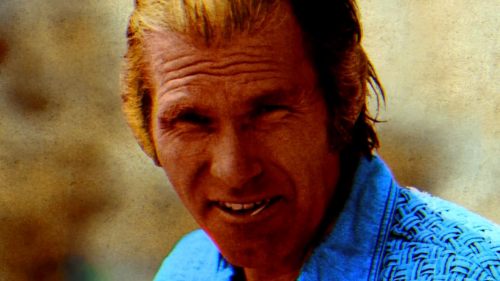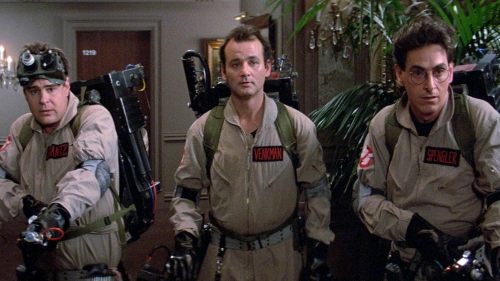Collins’ Crypt: Visiting The HOUSE BY THE CEMETERY
Much like Carpenter's "Apocalypse Trilogy" (The Thing, Prince of Darkness, In The Mouth of Madness), there isn't much to connect Lucio Fulci's so-called "Gates of Hell" trilogy, including the idea of a gate to hell. The third entry in this "series" is The House by the Cemetery (Italian title: Quella villa accanto al cimitero), and while it has an undead villain and actress Catriona MacColl (who appeared in all three films, albeit as different characters), there's no real mention of hell in the film, nor is there an "all hell breaks loose" type finale that the other two films - City of the Living Dead and The Beyond - offered as the climax to their sprawling, occasionally incomprehensible narratives. His earlier Zombie feels more in line with those two than this one, if you ask me.
But that's not to the film's detriment; on the contrary, I consider it the best of the trio. While revisiting the film with the new Blue Underground special edition Blu-ray (an improvement on their already impressive 2011 release, more on that later), I realized that it wasn't the lack of a hellgate that set it apart from its predecessors - it was its relative coherence and focus, which allowed the suspense to register in ways those films never fully managed for me. Don't get me wrong, I enjoy them quite a bit, but both of them have "and then this happens, and then this happens" kind of plots and a surplus of characters that make the films seem somewhat unfocused, as if Fulci figured it might be easier to frighten us if we were distracted by trying to remember who was who and what they wanted to accomplish. And both films eventually come down to whoever's still alive facing off against a swarm of zombies before something confusing happens before the credits roll, making it hard to remember which is which if you've only seen them once or twice each.
House by the Cemetery, on the other hand, really only has the one antagonist: a ghoul named Dr. Freudstein who is confined to the basement of the eponymous house (and unlike The Beyond, the basement-heavy plot actually makes sense, as this one takes place in Massachusetts, not New Orleans). This gives the movie a bit of a slasher flavor as opposed to a traditional zombie movie like the other two, particularly in the opening scene where Freudstein offs a pair of young lovers who have used his "abandoned" house as a makeout spot. After that opener, we meet our hero family (two parents and their young son Bob), and for the rest of the film's 90 minutes, we rarely spend any time away from their POV. There are a few supporting characters, like a meddling realtor and Bob's babysitter Ann, but Fulci rarely focuses on them for very long, keeping a tight leash on his storyline even if it means going longer than usual without any major carnage.

So yeah, it's not quite as action-packed as his other films, as there are only a handful of death scenes and a plot that confines the villain to a single room. But in a way that makes it more impressive with regards to Fulci's direction and co-writing, as he didn't "cheat" and throw in ghostly possession or other out of nowhere elements just to have someone die a horrible death even though they weren't in the basement with Freudstein. Instead he gives us a fairly thorough account of how Freudstein ended up that way in the first place and what he wants now, limiting the amount of time you the viewer will be asking "Wait, what's going on now?" or wondering if the film's umpteenth new character will be important or not. Naturally, if that sort of dream logic/kitchen sink approach is what you find appealing in the other movies, you might feel a bit bored or unsatisfied here, but for me personally it's more my speed.
That said, the gore scenes are pretty great, and don't run the risk of making me sick! I don't get squeamish easily, but I definitely felt... *something* in my throat the first time I watched the car scene in City of the Living Dead (which I first saw with the US title, Gates of Hell), when Danieli Doria's character literally pukes her guts out - there's nothing like that here. Doria herself plays the opening scene victim, who merely gets stabbed in the back of the head - the equivalent of a noogie in a Fulci movie. The ickiest scene is probably a bat attack around the midway point, when the thing latches onto the hand of our hero Norman (Paolo Malco) and won't stop biting until the man has used a few tools to drain it of the seven or eight gallons of blood the damn thing seemingly held in its little body. Norman's wife (MacColl) and son get splattered as he wildly swings his hand around trying to get rid of it, and it's making that high-pitched squeal the whole time... it's really unnerving.
Speaking of the son - let's talk about Bob. Poor, poor Bob. The young actor (Giovanni Frezza) is fine, but unfortunately the person who dubbed him (Lyle Stetler, per the IMDb - must be true!) sounds more like a teenaged girl than a young boy, making each and every line a potential howler regardless of what is actually happening in the scene. Granted, some of his lines would be funny no matter what ("Mommy says you're not dead!" he shouts hopefully as he searches for a friend who is indeed, quite dead), but even his most benign dialogue is distracting due to the mismatched actor. Usually when people complain about a bad dub job they're referring to the lips moving at completely different times than the spoken audio, but in House's case, no sync issue is nearly as damaging as the fact that hearing Gilbert Gottfried's voice coming out of Barack Obama would be less jarring.

And while we're on the topic of the English dub, this film has one of the more curious cases of a common translation issue, where if you turn on the English subtitles you might see different things being said. Usually it's just one track having a stripped-down version of what the other track is saying (So, something like "Hey, would you like to join us for dinner tonight?" will become "Want to come over?"), but for this film you actually get a different subplot! Per House expert Ted Geoghegan (whose film We Are Still Here was a Fulci love letter, with this film in particular providing much of the influence), the American distributor figured the film could benefit from being a bit more simplistic, so the subplot about Norman's predecessor's suicide was reduced to a few brief mentions, when in reality his character was just as interested in understanding what led to the man's death as he was continuing his work. Blue Underground's blu offers two English subtitle tracks; one that more or less matches the dub, and one that translates the Italian audio - put that one on along with the dub for a truly strange viewing experience during certain scenes (particularly the one with Fulci's cameo as another colleague of Norman's), as they will have completely different conversations that both "work" just fine.
That's just one of the many ways that the Blu-ray delivers, and improves on the 2011 release. It's a new transfer from a 4K restoration, and looks as gorgeous as you'd expect, plus all of those bonus features have been carried over, but they've added a commentary by Fulci historian Troy Howarth, whose tracks are always among the better examples of their kind. He knows that these movies have a few lapses and isn't afraid to point them out, but it's not in a snarky, wannabe-MST3k kind of way - and all you have to do is listen to the next 10-15 seconds to be assured that he genuinely enjoys the film he is viewing. He also doesn't spend too much time reciting the actors' filmographies, instead only highlighting relevant examples to provide context for how it relates to the film at hand. Another new piece is a solid interview with Stephen Thrower, another Fulci historian (he wrote Beyond Terror, a book that sounds quite good but runs for hundreds of dollars on Amazon, so I'll h(ave to put that on the ol' wishlist), and the limited edition comes with the great soundtrack from Walter Rizzati and a booklet by our pal Michael Gingold, so it's worth springing for if you ask me.
I was relatively late to the party with Fulci; apart from Zombie (age 15 or so) I didn't catch any of his films until I was deep into my 20s, and in fact there are some I still haven't seen (including Manhattan Baby, which came out the following year). But this was the one that really made me a fan of the filmmaker, and remains a favorite as I've taken in more of his horror-centric filmography (both earlier stuff like Don't Torture a Duckling, and late-period films that warrant no further discussion). US availability (and cost) make seeing his entire output a challenge I'm not sure I'm up for, but since I find his films so easily rewatchable, it's not the end of the world if I'm forever "stuck" with the handful of ones any seasoned horror fan could name off the top of their head. There's probably a reason they're in that position while the likes of Door to Silence are not.



